Market recovers in second half of month to post strong 2.17% return; foreign markets performed even better while sustainable fund indices lagged, matched or exceeded their conventional counterparts
In a month that produced returns ranging from highs of 8.05% posted by European emerging markets to 7.73% recorded by NASDAQ biotech stocks and 4.97% for Japanese stocks to lows between -2.48% and -1.27% achieved by utilities and energy stocks, the broad US stock market delivered a positive 2.17% total return in October, the fifth best month so far this year. But the path to achieving this gain was not linear. The S&P 500 was in the red after ten trading days through October 14 when, at close, it recorded a month-to-date decline of -0.356% as it labored through geopolitical and economic uncertainties at home and abroad ahead of earnings season. Refer to Chart 1. Thereafter, investor pessimism was overcome in response to an announcement that the US and China had reached a “phase one” agreement pursuant to which China would buy more US farm goods while the US reciprocates by holding off on the imposition of new tariffs on October 15. Still, trade negotiations can turn on a dime and unless an agreement is executed, US-China trade will continue to cast a shadow over the market. Further, worries about the slowing US economy retreated somewhat after companies began to report better than expected third quarter results. Stocks moved decisively higher as earnings season shifted into high gear. With 71% of S&P 500 companies reporting by November 1st, 76% reported earnings above consensus estimates. That said, expectations for third-quarter earnings were low as analysts had revised their estimates lower over the summer due to economic concerns.
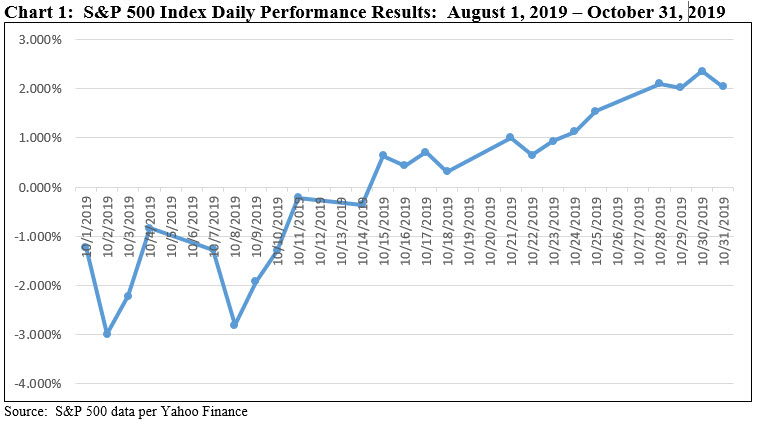
Investors focus on positive economic news
Investors seemed to shrug off the rather chaotic political environment in the United States, including a vote by the House of Representatives on a roadmap for impeachment, reacting instead to positive economic news such as the strong jobs data report released by the Department of Labor on the last day of the month showing that the US economy added 128,000 jobs in October while unemployment rose to 3.6%. The release followed the Federal Reserve Bank’s decision during the last week of the month to cut its benchmark interest rate for the third time since July in an attempt to stimulate the economy while signaling that it was done cutting rates unless it sees a significant slowing. In the meantime, growth, according to Fed Vice Chairman Richard Clarida, “has been supported by the continued strength of household consumption, underpinned, in turn by a thriving labor market.” This was reflected in better than expected labor statistics issued at the end of the month and also the “second” gross domestic product (GDP) estimate released on October 30th. According to the Bureau of Economic Analysis, the US economy increased at an annual rate of 1.9% in the third quarter of 2019 versus a second quarter real GDP gain of 2.0% while price inflation remained below 2%. The increase in real GDP in the third quarter reflected positive contributions from consumer spending, federal government spending, residential fixed investment, state and local government spending, and exports that were partly offset by continued weakness in the manufacturing sector. Overall, these conditions are expected to persist over the next several months and should therefore be generally favorable for the stock market.
When the month closed, eight of 11 sectors posted average gains, topped by the Health Care sector that was up a full 5.0%, while three sectors, including Real Estate, Utilities and Energy ended lower -0.80%, -0.16% and -2.40%, respectively. Small company stocks outperformed large cap stocks, as the Russell 2000 added 2.63%, its best total return in the last four months. Small company growth stocks eclipsed small cap value stocks by 43 basis points, but the reverse was true for large cap stocks with a value bent that gained 2.65% versus 1.74% for their growth oriented counterparts.
Foreign equity markets performed even better as the MSCI ACWI ex USA (NR) delivered 3.49% return
Foreign equity markets performed even better, with the MSCI ACWI ex USA (Net) delivering a 3.49% return. European and Asian markets benefited from a relaxation in trade tensions between the U.S. and China and an improving outlook for a Brexit agreement. European stocks were mixed, with export-sensitive Germany’s DAX index jumping 3.53% and France’s CAC 40 gaining 0.92%. Great Britain’s FTSE index, however, lost -2.16%. Pacific Rim stocks enjoyed solid performance, with Japan’s Nikkei index picking up 5.54% and China’s Hang Seng adding 3.12%. Argentina’s volatile Merval index jumped 20.4% and is now up for the year.
Intermediate-term investment grade bonds gain 0.30%
At the same time, intermediate-term investment grade bonds, measured by the Bloomberg Barclays Aggregate US Index, gained 0.3% and only partially reversed last month’s -0.64% decline. With 30-year Treasury bond yields gaining 5 basis points during the month, longer-dated US Treasuries posted negative returns for the month.
Sustainable (SUSTAIN) Large Cap Equity Fund Index trailed S&P 500 by 51 bps
At 1.66%, the SUSTAIN Large Cap Equity Fund Index trailed the S&P 500 in October for the second month in a row, trailing behind by 51 basis points as the large cap conventional index added 2.17%. As a result, the SUSTAIN Index now also lags the S&P 500 by 58 basis points over the previous 3-months to October 31st.
Only three of the ten funds that comprise the index outperformed the S&P 500, including Pax Large Cap Fund Institutional, which was the second best performer last month, JPMorgan US Equity R6 and Domini Impact Equity Fund Investor. These three large cap blend funds posted returns of 2.88%, 2.74% and 2.58%, respectively. All three funds benefited from overweight positions in Microsoft (MSFT), Amazon (AMZN) and Alphabet (GOOG) and/or Apple (AAPL) that performed well in October, gaining between 2.88% (AMZN) and 16.14% (Apple). In the case of Domini, it also was given a lift from its 11.14% in non-US equities. The same funds pursue sustainable investing using varying strategies, starting with J.P. Morgan that relies exclusively on ESG integration, to Pax which applies a combination of exclusions, ESG integration and shareholder engagement approach, to Domini which extends Pax’s approach to also include an emphasis on the achievement of impact. Refer to Table 1.
At the other end of the range, Calvert Equity A posted the only negative return for the month, giving up -0.19% following last month’s -2.77% decline. The fund remains solidly ahead on a year-to-date basis with a 29.36% gain.
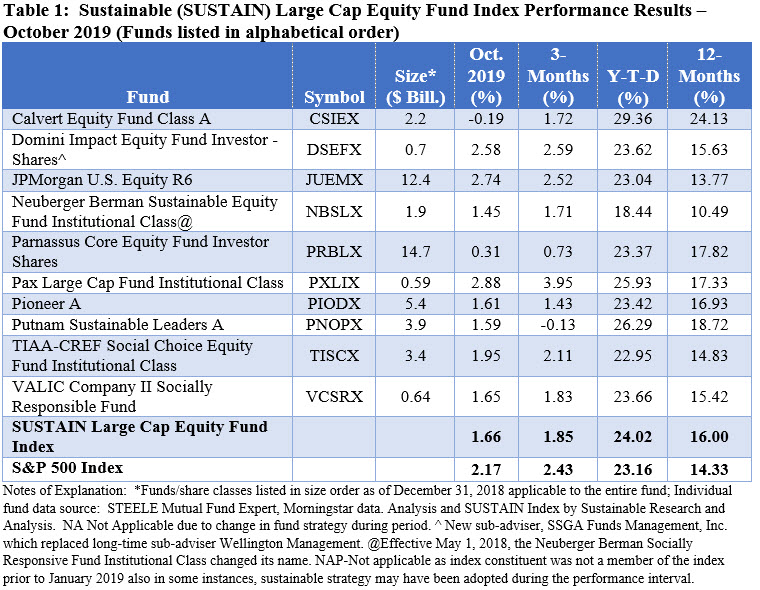
On a year-to-date basis and trailing 12-months, SUSTAIN Larger Cap Equity beat the S&P 500 by 0.86% and 1.67%. Refer to Chart 2.
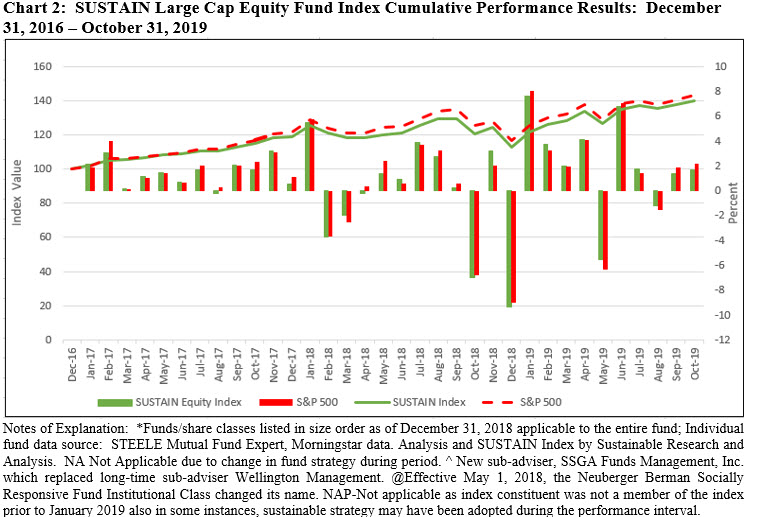
Sustainable (SUSTAIN) Bond Fund Index matched the performance of its conventional index
After several non-consecutive months this year of outsized fixed income returns that produced a 9.23% year-to-date return for the SUSTAIN Bond Fund Index and 8.85% return for the Bloomberg Barclays US Aggregate Index, in line with declining interest rates, results over the previous two months have been slim to negative. As long-term rates have risen to remaining stable on a month over month basis since August month-end, SUSTAIN Bond Fund Index gave up -0.58% in September while adding 0.30% in October. The SUSTAIN Index just about matched the Bloomberg Barclays US Aggregate Index, benefiting from the above index performance of four of 10 member funds that posted results ranging from 0.32% to a high of 0.46% recorded by the $1.4 billion largely institutional PIMCO Total Return ESG Fund Institutional that integrates ESG factors and conducts company engagements. The fund also bested the Bloomberg Barclays benchmark over the trailing three months and year-to-date basis.
Lagging funds include Domini Impact Bond Fund Investor shares and Touchstone Impact Bond Fund Institutional shares that generated 0.21% and 0.25% returns for the month. Refer to Table 2 and Chart 3.
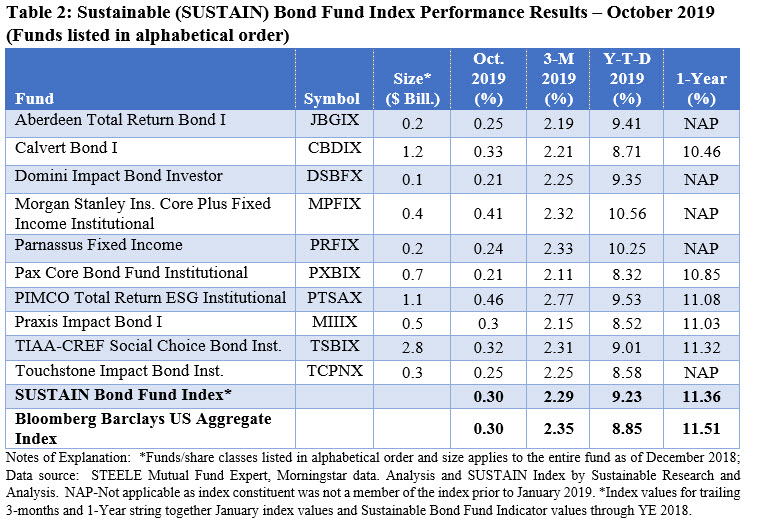
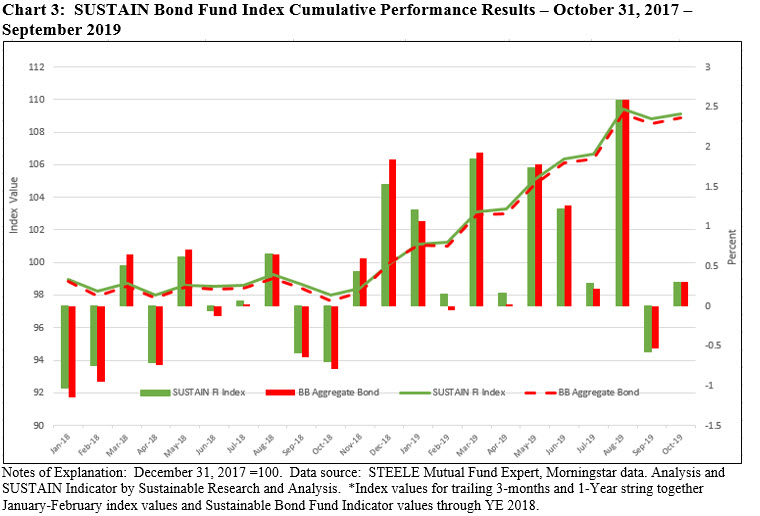
Sustainable (SUSTAIN) Foreign Equity Fund Index led MSCI ACWI ex USA by 7 basis points
The SUSTAIN Foreign Equity Fund Index continues, for the third month in a row, to outperform the MSCI ACWI ex USA (NR) Index. Posting a 3.56% return in October, the SUSTAIN Foreign Equity Fund Index led the conventional benchmark by 7 basis points. October’s return was bolstered by the performance of five funds that recorded returns in excess of the MSCI ACWI ex USA’s 3.5%, led by the large cap blend UBS International Sustainable Equity P Fund that delivered a 4.41% total return. The fund came into October with an overweight position in the Technology sector, allocating 17.94% versus a benchmark exposure of 9.06%. Moreover, the fund had tilted its portfolio in favor of developed European countries, Japan and the UK given the fund’s 38.24%, 20.03% and 13.27% weights relative to the benchmark’s allocation of 30.24%, 16.88% and 10.61%, respectively.
Over the trailing 3-months, the SUSTAIN Foreign Equity Fund Index gained 4.24% for a 1.37% differential relative to the MSCI ACWI, ex USA as eight of the ten funds have outperformed with returns as high as 5.68% recorded by TIAA-CREF Social Choice International Equity Fund Institutional. The same fund leads on a year-to-date and trailing 12-month basis with returns of 18.35% and 12.77%. Templeton Institutional International Equity Series Fund-Primary, a value-oriented ESG integrator that has been lagging for nine consecutive months through August of this year, seems to be have been picking up momentum in the last two months. Refer to Table 3 and Chart 4.
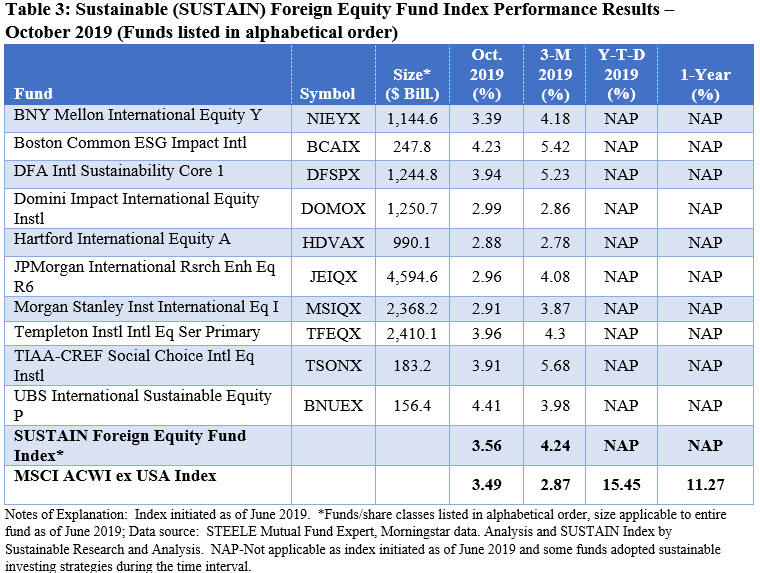
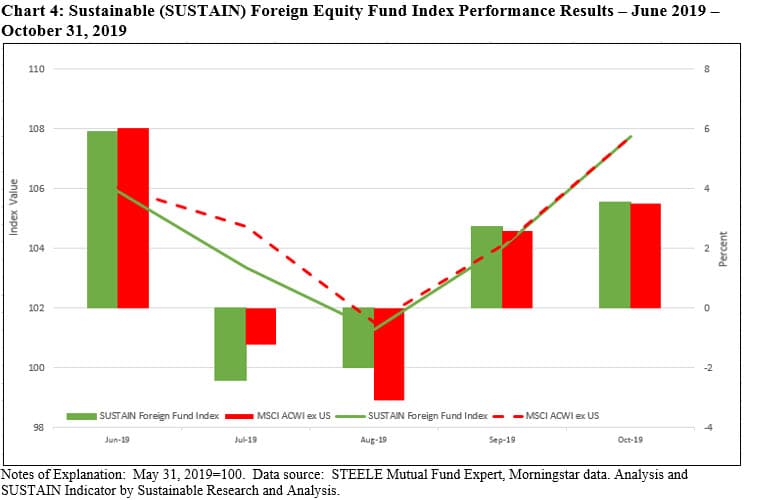
Performance of ESG indices in October versus non-ESG Indices: US ESG Equities and International/World ESG Equities outperformed while bond ESG Indices matched their conventional counterpart
US Equities-The S&P 500 ESG Index was the clear winner in October, gaining 2.39% for a 22 basis point advantage relative to the conventional S&P 500. At the same time, the S&P 500 index also beat out the MSCI USA ESG Leaders Index, MSCI KLD 400 Index, MSCI USA Index and the Sustainable (SUSTAIN) Large Cap Equity Fund Index by between 21 bps and 51 bps. Refer to Chart 5.
International/World Equities-The MSCI ACWI ex USA ESG Leaders Index, MSCI EAFE ESG Index and MSCI Emerging Markets ESG Index each led its conventional counterpart by between 31 bps and 63 bps. Refer to Chart 5.
Fixed Income-The MSCI Bloomberg Barclays ESG US Aggregate Index, the Bloomberg Barclays US Aggregate and the Sustainable (SUSTAIN) Bond Fund Index each posted a return of 0.30%. Refer to Chart 5.
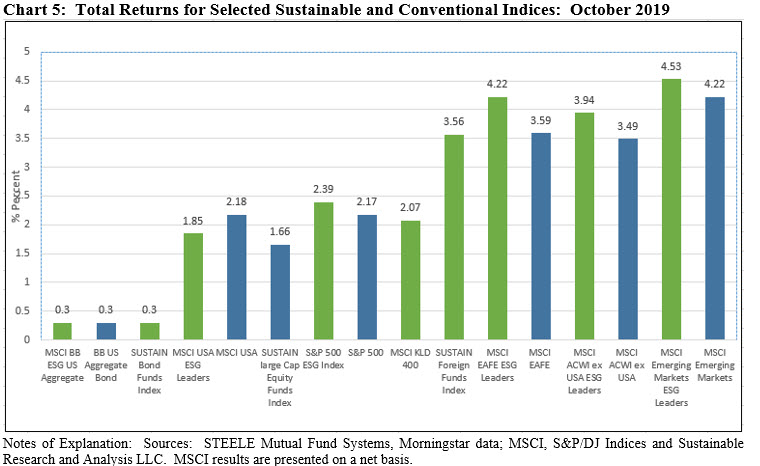
Sustainable Indices Lagged, Matched or Exceeded Returns for the Month of October 2019
Market recovers in second half of month to post strong 2.17% return; foreign markets performed even better while sustainable fund indices lagged, matched or exceeded their conventional counterparts In a month that produced returns ranging from highs of 8.05% posted by European emerging markets to 7.73% recorded by NASDAQ biotech stocks and 4.97% for Japanese…
Share This Article:
Market recovers in second half of month to post strong 2.17% return; foreign markets performed even better while sustainable fund indices lagged, matched or exceeded their conventional counterparts
In a month that produced returns ranging from highs of 8.05% posted by European emerging markets to 7.73% recorded by NASDAQ biotech stocks and 4.97% for Japanese stocks to lows between -2.48% and -1.27% achieved by utilities and energy stocks, the broad US stock market delivered a positive 2.17% total return in October, the fifth best month so far this year. But the path to achieving this gain was not linear. The S&P 500 was in the red after ten trading days through October 14 when, at close, it recorded a month-to-date decline of -0.356% as it labored through geopolitical and economic uncertainties at home and abroad ahead of earnings season. Refer to Chart 1. Thereafter, investor pessimism was overcome in response to an announcement that the US and China had reached a “phase one” agreement pursuant to which China would buy more US farm goods while the US reciprocates by holding off on the imposition of new tariffs on October 15. Still, trade negotiations can turn on a dime and unless an agreement is executed, US-China trade will continue to cast a shadow over the market. Further, worries about the slowing US economy retreated somewhat after companies began to report better than expected third quarter results. Stocks moved decisively higher as earnings season shifted into high gear. With 71% of S&P 500 companies reporting by November 1st, 76% reported earnings above consensus estimates. That said, expectations for third-quarter earnings were low as analysts had revised their estimates lower over the summer due to economic concerns.
Investors focus on positive economic news
Investors seemed to shrug off the rather chaotic political environment in the United States, including a vote by the House of Representatives on a roadmap for impeachment, reacting instead to positive economic news such as the strong jobs data report released by the Department of Labor on the last day of the month showing that the US economy added 128,000 jobs in October while unemployment rose to 3.6%. The release followed the Federal Reserve Bank’s decision during the last week of the month to cut its benchmark interest rate for the third time since July in an attempt to stimulate the economy while signaling that it was done cutting rates unless it sees a significant slowing. In the meantime, growth, according to Fed Vice Chairman Richard Clarida, “has been supported by the continued strength of household consumption, underpinned, in turn by a thriving labor market.” This was reflected in better than expected labor statistics issued at the end of the month and also the “second” gross domestic product (GDP) estimate released on October 30th. According to the Bureau of Economic Analysis, the US economy increased at an annual rate of 1.9% in the third quarter of 2019 versus a second quarter real GDP gain of 2.0% while price inflation remained below 2%. The increase in real GDP in the third quarter reflected positive contributions from consumer spending, federal government spending, residential fixed investment, state and local government spending, and exports that were partly offset by continued weakness in the manufacturing sector. Overall, these conditions are expected to persist over the next several months and should therefore be generally favorable for the stock market.
When the month closed, eight of 11 sectors posted average gains, topped by the Health Care sector that was up a full 5.0%, while three sectors, including Real Estate, Utilities and Energy ended lower -0.80%, -0.16% and -2.40%, respectively. Small company stocks outperformed large cap stocks, as the Russell 2000 added 2.63%, its best total return in the last four months. Small company growth stocks eclipsed small cap value stocks by 43 basis points, but the reverse was true for large cap stocks with a value bent that gained 2.65% versus 1.74% for their growth oriented counterparts.
Foreign equity markets performed even better as the MSCI ACWI ex USA (NR) delivered 3.49% return
Foreign equity markets performed even better, with the MSCI ACWI ex USA (Net) delivering a 3.49% return. European and Asian markets benefited from a relaxation in trade tensions between the U.S. and China and an improving outlook for a Brexit agreement. European stocks were mixed, with export-sensitive Germany’s DAX index jumping 3.53% and France’s CAC 40 gaining 0.92%. Great Britain’s FTSE index, however, lost -2.16%. Pacific Rim stocks enjoyed solid performance, with Japan’s Nikkei index picking up 5.54% and China’s Hang Seng adding 3.12%. Argentina’s volatile Merval index jumped 20.4% and is now up for the year.
Intermediate-term investment grade bonds gain 0.30%
At the same time, intermediate-term investment grade bonds, measured by the Bloomberg Barclays Aggregate US Index, gained 0.3% and only partially reversed last month’s -0.64% decline. With 30-year Treasury bond yields gaining 5 basis points during the month, longer-dated US Treasuries posted negative returns for the month.
Sustainable (SUSTAIN) Large Cap Equity Fund Index trailed S&P 500 by 51 bps
At 1.66%, the SUSTAIN Large Cap Equity Fund Index trailed the S&P 500 in October for the second month in a row, trailing behind by 51 basis points as the large cap conventional index added 2.17%. As a result, the SUSTAIN Index now also lags the S&P 500 by 58 basis points over the previous 3-months to October 31st.
Only three of the ten funds that comprise the index outperformed the S&P 500, including Pax Large Cap Fund Institutional, which was the second best performer last month, JPMorgan US Equity R6 and Domini Impact Equity Fund Investor. These three large cap blend funds posted returns of 2.88%, 2.74% and 2.58%, respectively. All three funds benefited from overweight positions in Microsoft (MSFT), Amazon (AMZN) and Alphabet (GOOG) and/or Apple (AAPL) that performed well in October, gaining between 2.88% (AMZN) and 16.14% (Apple). In the case of Domini, it also was given a lift from its 11.14% in non-US equities. The same funds pursue sustainable investing using varying strategies, starting with J.P. Morgan that relies exclusively on ESG integration, to Pax which applies a combination of exclusions, ESG integration and shareholder engagement approach, to Domini which extends Pax’s approach to also include an emphasis on the achievement of impact. Refer to Table 1.
At the other end of the range, Calvert Equity A posted the only negative return for the month, giving up -0.19% following last month’s -2.77% decline. The fund remains solidly ahead on a year-to-date basis with a 29.36% gain.
On a year-to-date basis and trailing 12-months, SUSTAIN Larger Cap Equity beat the S&P 500 by 0.86% and 1.67%. Refer to Chart 2.
Sustainable (SUSTAIN) Bond Fund Index matched the performance of its conventional index
After several non-consecutive months this year of outsized fixed income returns that produced a 9.23% year-to-date return for the SUSTAIN Bond Fund Index and 8.85% return for the Bloomberg Barclays US Aggregate Index, in line with declining interest rates, results over the previous two months have been slim to negative. As long-term rates have risen to remaining stable on a month over month basis since August month-end, SUSTAIN Bond Fund Index gave up -0.58% in September while adding 0.30% in October. The SUSTAIN Index just about matched the Bloomberg Barclays US Aggregate Index, benefiting from the above index performance of four of 10 member funds that posted results ranging from 0.32% to a high of 0.46% recorded by the $1.4 billion largely institutional PIMCO Total Return ESG Fund Institutional that integrates ESG factors and conducts company engagements. The fund also bested the Bloomberg Barclays benchmark over the trailing three months and year-to-date basis.
Lagging funds include Domini Impact Bond Fund Investor shares and Touchstone Impact Bond Fund Institutional shares that generated 0.21% and 0.25% returns for the month. Refer to Table 2 and Chart 3.

Sustainable (SUSTAIN) Foreign Equity Fund Index led MSCI ACWI ex USA by 7 basis points
The SUSTAIN Foreign Equity Fund Index continues, for the third month in a row, to outperform the MSCI ACWI ex USA (NR) Index. Posting a 3.56% return in October, the SUSTAIN Foreign Equity Fund Index led the conventional benchmark by 7 basis points. October’s return was bolstered by the performance of five funds that recorded returns in excess of the MSCI ACWI ex USA’s 3.5%, led by the large cap blend UBS International Sustainable Equity P Fund that delivered a 4.41% total return. The fund came into October with an overweight position in the Technology sector, allocating 17.94% versus a benchmark exposure of 9.06%. Moreover, the fund had tilted its portfolio in favor of developed European countries, Japan and the UK given the fund’s 38.24%, 20.03% and 13.27% weights relative to the benchmark’s allocation of 30.24%, 16.88% and 10.61%, respectively.
Over the trailing 3-months, the SUSTAIN Foreign Equity Fund Index gained 4.24% for a 1.37% differential relative to the MSCI ACWI, ex USA as eight of the ten funds have outperformed with returns as high as 5.68% recorded by TIAA-CREF Social Choice International Equity Fund Institutional. The same fund leads on a year-to-date and trailing 12-month basis with returns of 18.35% and 12.77%. Templeton Institutional International Equity Series Fund-Primary, a value-oriented ESG integrator that has been lagging for nine consecutive months through August of this year, seems to be have been picking up momentum in the last two months. Refer to Table 3 and Chart 4.
Performance of ESG indices in October versus non-ESG Indices: US ESG Equities and International/World ESG Equities outperformed while bond ESG Indices matched their conventional counterpart
US Equities-The S&P 500 ESG Index was the clear winner in October, gaining 2.39% for a 22 basis point advantage relative to the conventional S&P 500. At the same time, the S&P 500 index also beat out the MSCI USA ESG Leaders Index, MSCI KLD 400 Index, MSCI USA Index and the Sustainable (SUSTAIN) Large Cap Equity Fund Index by between 21 bps and 51 bps. Refer to Chart 5.
International/World Equities-The MSCI ACWI ex USA ESG Leaders Index, MSCI EAFE ESG Index and MSCI Emerging Markets ESG Index each led its conventional counterpart by between 31 bps and 63 bps. Refer to Chart 5.
Fixed Income-The MSCI Bloomberg Barclays ESG US Aggregate Index, the Bloomberg Barclays US Aggregate and the Sustainable (SUSTAIN) Bond Fund Index each posted a return of 0.30%. Refer to Chart 5.
Sustainableinvest.com
Benefits
Free access to regularly updated original research and analysis focused exclusively on sustainable finance and investing, providing investors with the guidance needed to make informed investment decisions that align with their personal values and financial goals while also contributing to the advancement of positive long-term environmental and social outcomes.
By offering financial support for our current work, either in the form of a one-time or regular contributions, you help to defray some of the costs associated with conducting our research and analysis as well as to maintain the www.sustainablest.wpengine.com website.
Helping us to expand our research capabilities and offerings over time to cover additional relevant topics geared to sustainable investors.
Sign up to free newsletters.
By submitting this form, you are consenting to receive marketing emails from: . You can revoke your consent to receive emails at any time by using the SafeUnsubscribe® link, found at the bottom of every email. Emails are serviced by Constant Contact